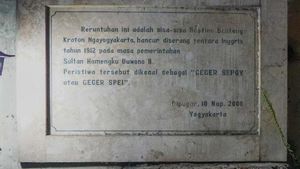JAKARTA - The Dutch trading conspiracy, the VOC, may be proud to have built the city of Batavia. A comfortable center of power with city planning resembles a city in the Netherlands. The city was deliberately fortified with towering walls so that there would be no disturbance from the outside world: humans or wild animals.
Once they dared to go outside Batavia, they would invite disaster. The river or river is one of the most dangerous places. The presence of wild animals such as crocodiles in large numbers was the culprit for the Dutch who were killed and killed.
The Company managed to break through Jayakarta in 1619. This success made the Company expel the entire population of Jayakarta. The Company did not want to live side by side with the natives. This condition made the Company build the city of Batavia on the rubble of the ruins of Jayakarta.
The city was created in accordance with the creation of the Dutch in general. They want city planning similar to their hometowns in the Netherlands. Even though their lives are isolated. The power of attorney then equipped Batavia City by fortifying itself from the outside world: Ommelanden (the Batavian extreme area).
The presence of the fort symbolizes the fear that the residents of Batavia have contained. They are afraid of being attacked by the natives. They are also afraid of being attacked by wild animals. Regarding wild animals themselves, not new things in Batavia, the early era of the VOC power.
The reason is none other than because most of the Ommelanden areas are still wilderness. Many places have not been touched by humans. This condition is a comfortable home for wild animals such as tigers to crocodiles.
Anyone who tries to walk outside the city walls without strict escort will surely face the only threat: death. The threat is not to scare. All because death by wild animals is often a warm news for the whole of Batavia.
The Dutch and their slaves must at least think long before stepping foot outside the gates of Batavia City. Because, leaving Batavia, whatever the reason, will extend the list of deaths by wild animals.
SEE ALSO:
To show how forests have been close to humans for a long time, it is enough to be reminded here that wild animals survive in Java until the early 20th century. And until now, Westerners still imagine that the archipelago is full of wild animals.
"In the 17th century, it is still possible for tigers to roam in the streets of Batavia, and one of the paintings left by Pastor Valentijn carefully describes Captain▁tujuhr shooting wild animals in the Kasteel Batavia field in 1694," said historian Denys Lombard in the book Nusa Java Cross Culture: Boundary-Batas of Sloping Volume 1(1996).
The Dutch considered tigers the most avoided animals. However, danger is not only present on land. Another greater danger also appears in the rivers in Batavia. Once the Dutch were careless about playing around the river, the crocodiles were ready to pounce.
The danger is not really a problem for the bumiputras. Local people understand which corner of the river is dangerous and which is not. In fact, there are also mystical activities that are being carried out. The Bumiputras tried to throw proposals into the water. They also felt they would not be colonized by crocodiles.
Problems arise. Knowledge related to hazard markers was not adopted by the Dutch. They just try to find entertainment by rising badly through the river. Disaster can arise at any time. Many also died because they acted carelessly until they were attacked by crocodiles.
The sad news continues to reverberate in Batava because of it. The threat of hungry crocodiles makes rivers an unwritten place for Batavians. However, the government is trying to take a stand. The owner of the power feels the loss of life because the crocodile is attacked more and more.
They also try to promise money to anyone who can catch a crocodile. The rule in fact increases the adrenaline of many people. They try to risk their lives by catching crocodiles in the river.
The activity was ineffective. The population of bejibun crocodiles and many residents who deliberately raise crocodiles to make pinak just to get money is an unresolved problem. However, the only thing that makes crocodiles completely disappear from Batavia - believe it or not - is massive development.
The animals are not only found in the Ciliwung, Krukut, or Angke rivers, but even in the ditches inside and outside the city walls. Those who often get the animals are the holders of permits to catch freshwater fish that usually use cages.
Not infrequently spending time alone while hunting for crocodiles by attaching a dog tied on a bamboo horn. Anyone who manages to catch a crocodile or snake, drag it to the riverbank and kill it, receive a wage of 10 reals. The existence of various wild binantangs that make residents nervous, reflected in the names of a number of trenches such as the Tiger Trench (Tigersgracht), Crocodile Trench (Kaaimansgracht), and Rhino Parit (Rinocerosgracht), "said historian Hendrik E. Niemeijer in the book Batavia: Colonial Society of the XVII Century (2012).
The English, Chinese, Japanese, Arabic, and French versions are automatically generated by the AI. So there may still be inaccuracies in translating, please always see Indonesian as our main language. (system supported by DigitalSiber.id)
















